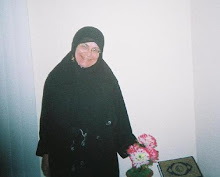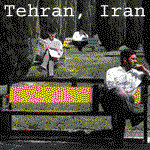Guantanamo Hunger Strikers Stay Defiant
 The basic possessions of a detainee are displayed in a maximum security cell at Camp V Delta, part of the the long-term detention facility at U.S. Naval Station Guantanamo Bay in Cuba, Wed., April 13, 2005. The items include an orange uniform, sandals, a Quran, a toothbrush and prayer beads. (AP Photo/Richard Ross).
The basic possessions of a detainee are displayed in a maximum security cell at Camp V Delta, part of the the long-term detention facility at U.S. Naval Station Guantanamo Bay in Cuba, Wed., April 13, 2005. The items include an orange uniform, sandals, a Quran, a toothbrush and prayer beads. (AP Photo/Richard Ross).By BEN FOX
GUANTANAMO BAY NAVAL BASE-Twice a day at the U.S. military prison here, Abdul Rahman Shalabi and Zaid Salim Zuhair Ahmed are strapped down in padded restraint chairs and flexible yellow tubes are inserted through their noses and throats. Milky nutritional supplements, mixed with water and olive oil to add calories and ease constipation, pour into their stomachs.
Shalabi, 32, an accused al-Qaida militant who was among the first prisoners taken to Guantanamo, and Ahmed, about 34, have refused to eat for almost two years to protest their conditions and open-ended confinement. In recent months, the number of hunger strikers has grown to two dozen, and the military is using force-feeding to keep them from starving.
An Associated Press investigation reveals the most complete picture yet of a test of wills that's taking place out of public view and shows no sign of ending, despite international outrage.
The restraint chair was a practice borrowed from U.S. civilian prisons in January 2006. Prisoners are strapped down and monitored to prevent vomiting until the supplements are digested.
The British human rights group Reprieve labeled the process "intentionally brutal" and Shalabi, according to his lawyer's notes, said it is painful, "something you can't imagine. For two years, me and Ahmed have been treated like animals."
The government says force-feeding detainees in the restraint chair was not meant to break the hunger strikes, but it had that effect. A mass protest that began in August 2005 and reached a peak of 131 detainees dwindled at one point to just two — Shalabi and Ahmed. In recent months, though, the number has grown again.
The military won't identify strikers, citing privacy rules and a desire to keep detainees from becoming martyrs.
But the AP was able to identify Shalabi and Ahmed, both Saudi Arabians, through interviews with several detainee lawyers and detailed military charts, obtained through the Freedom of Information Act, tracking the weights of each detainee.
Shalabi told his lawyer that other strikers include Sami al-Hajj, a Sudanese cameraman for Al-Jazeera, the Qatar-based Arabic-language TV station; Shaker Aamer, a Saudi who has acted as a camp leader; and Ghassan Abdullah al-Sharbi, a U.S.-educated Saudi engineer who told his captors he was proud to fight the U.S. and would consider it an honor to be given a life sentence.
"I don't quite see what they have gained from it," detention center commander Navy Rear Adm. Mark Buzby told the AP. "They are alive and healthy and we are going to keep them that way as long as they are here."
The military counted 24 men on hunger strike this week, including 23 receiving "enteral feeding" through tubes. It begins daily monitoring and considers force-feeding any detainee who misses nine consecutive meals. All are now at 100 percent of their ideal body weight because of the tube feedings, the military says.
"We never allow them to become seriously, medically compromised," said Navy Capt. Ronald Sollock, a doctor who commanded the detention center hospital from January 2006 until this month.
Guantanamo officials who deal directly with the strikers — and cannot be identified under military rules — cast doubt on their commitment. They say some were coerced by other detainees to stop eating and others eat McDonald's Happy Meals or Subway sandwiches provided by interrogators when they think other detainees won't find out.
And while detainees have complained of wounds from the repeated insertion and removal of the tubes, the military says it uses lubricants and local anesthetics to ease the pain.
Health experts unaffiliated with the military say there are no nutritional consequences from long-term tube feeding, that with proper care it can be done safely. Psychological and physical harm, however, are a real possibility.
Dr. Ronald Kleinman, chief of pediatric gastroenterology and nutrition at MassGeneral Hospital for Children, says there is a potential for "psychological consequences when this is done coercively," as well as "physical harm from repeatedly inserting a tube through the nose or leaving it in place inappropriately."
The previous Guantanamo commander, Navy Rear Adm. Harry Harris, underwent the process "just so he could say it was no big deal," Buzby said. He also says long-term strikers have complained at times when their feeding is delayed.
Prisoners have sporadically refused to eat at Guantanamo since shortly after they began arriving in January 2002. Detainees also show defiance by banging on their cell doors in concert for extended periods or hurling their bodily excretions at guards.
The mass hunger strike that began in August 2005, however, was something different. The prisoners compared themselves to the 10 Irish Republican Army hunger strikers who starved themselves to death in Britain's Maze prison in 1981 in hopes of winning status as political prisoners.
"Nobody should believe for one moment that my brothers here have less courage," Ethiopian detainee Binyam Mohammed warned in a statement released through his lawyer.
The Guantanamo hunger strikers were tube-fed, but many intentionally vomited the nutritional supplements and steadily lost weight.
By that December, at least 19 of 29 remaining strikers were significantly malnourished and at "great risk" of complications such as infection, permanent organ damage and injuries from weakened bones and muscles, according to an affidavit filed by a former hospital commander, Navy Capt. Stephen Hooker, in support of the military's response.
In early 2006, the military started using the restraint chairs, which strap down their arms and legs, to prevent detainees from resisting feeding efforts or making themselves vomit.
Among opponents were the International Committee of the Red Cross and Physicians for Human Rights. "We believe the will of the detainee must be respected," Red Cross spokesman Simon Schorno said.
The number of strikers has increased again recently, lawyers say, in protest of their increased isolation in Camp 6, the newest section of Guantanamo, where detainees spend most of the day alone in solid-wall cells. About 360 men are still being held at Guantanamo on suspicion of terrorism or links to al-Qaida or the Taliban.
The U.S. considers refusing to eat to be a disciplinary infraction and confiscates so-called comfort items such as mattresses and long underwear from their air-conditioned cells. Detainees must sleep on thin mats, can't get books or magazines other than the Quran and can have paper and pens to write letters for only an hour or so a day.
Shalabi and Ahmed have regained their weight since their captors began strapping them down. The records show Shalabi's weight dropped from 124 pounds to 106 pounds in January 2006, when the use of the restraint chair began. His lawyer says he now weighs about 155. Ahmed dropped from 149 pounds to 108 in December 2005 and was 143 pounds at the end of last year. His current weight is unknown.
The military doesn't allow detainee interviews, and Ahmed has no known lawyer. But Shalabi told New York attorney Julia Tarver Mason that after more than five years in detention without being charged, the strikers see their protest as a grueling but necessary struggle against indefinite confinement.
"I think he just feels hopeless that the law doesn't apply to him," Mason said.
A slight man with a short beard, Shalabi appeared in better health in June than when they previously met in October 2005, when he was "gaunt and emaciated," Mason said. But the strike has taken its toll. "He looks very old for someone his age. ... If I saw him anywhere else," the lawyer said, "I would think he's a man in his 50s."
The Bush administration maintains the detainees have no right to challenge their confinement in U.S. courts. They may, however, have some reason to feel less hopeless now: Reversing an earlier decision, the U.S. Supreme Court has agreed to review the question, and a decision is expected next year.
Labels: Guantanamo Bay, United States















0 Comments:
Post a Comment
<< Home